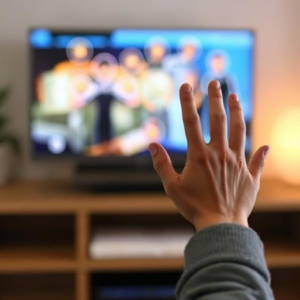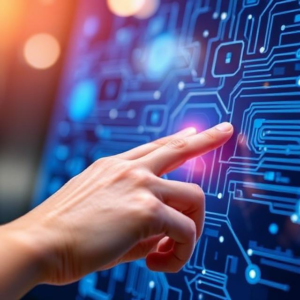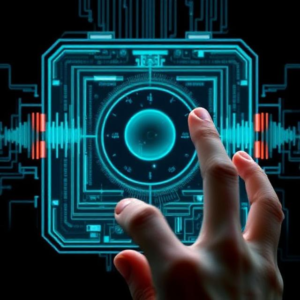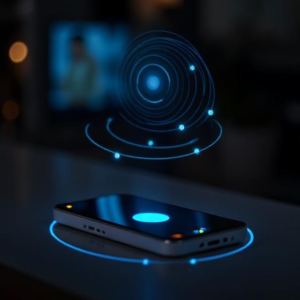What is Gesture Recognition Technology?
Gesture recognition is a type of technology that allows devices (like computers, smartphones, or smart TVs) to understand and respond to human movements or gestures. Instead of using a mouse, keyboard, or touch screen, you can control or interact with a device simply by making hand movements, body motions, or facial expressions.
Think of it like when you wave your hand in front of a smart TV to change the channel or use your hand to control a game character in a video game. Gesture recognition allows you to communicate with devices using natural movements, just like how you communicate with other people using gestures.

How Does Gesture Recognition Work?
Gesture recognition typically involves sensors and software that work together to detect and interpret the gestures. Let’s look at the key components of how this technology works:
- Sensors:
- The first thing needed is sensors that can detect the movement of your body, hands, or face. These sensors can be of different types:
- Cameras: Standard cameras or infrared cameras capture images or videos of your movements. Some systems use 3D cameras to detect depth and capture more detailed gestures.
- Accelerometers: These sensors detect motion and acceleration in space. They’re commonly used in wearable devices (like smartwatches) to recognize gestures.
- Gyroscopes: These measure orientation or rotation and are often used together with accelerometers to track your movements.
- Infrared Sensors: Used to detect objects or body parts in the infrared spectrum, these sensors can be very accurate at tracking movements, even in low light.
- The first thing needed is sensors that can detect the movement of your body, hands, or face. These sensors can be of different types:
- Processing:
- Once the sensors capture the gesture, the data is sent to the device’s processor. The processor uses software (often powered by machine learning algorithms) to interpret the movement and recognize what gesture you made.
- The software compares the captured movement with pre-defined gestures or patterns to understand what action you want to perform.
- Response:
- Once the device interprets the gesture, it performs an action based on it. For example, if you wave your hand in front of a smart TV, it might change the channel or volume.
Types of Gestures
There are many types of gestures that can be recognized, including:
- Hand Gestures:
- Swiping: Moving your hand or finger across the air or screen to perform an action (like scrolling or changing a page).
- Pointing: Indicating a direction or selecting an object by pointing your finger at it.
- Fist or open hand: Closing or opening your hand to trigger specific actions, such as pausing or playing a video.
- Body Gestures:
- Head nodding: Moving your head up and down (like saying “yes”).
- Waving: Moving your hand in a waving motion to greet or interact with a device.
- Facial Expressions:
- Smiling or frowning: Some systems can recognize facial expressions like a smile or a frown and use them to trigger actions, like activating a feature or taking a photo.
- Full-body Movements:
- In advanced systems, full-body gestures (like jumping or dancing) can be recognized. This is often used in video games or fitness applications, where your whole body is tracked for interaction.
Applications of Gesture Recognition
Gesture recognition has many uses in different areas. Some common applications include:
- Gaming:
- Motion-based games (like those played on gaming consoles like the Nintendo Wii or Xbox Kinect) use gesture recognition to detect player movements and allow them to control game characters or actions.
- Virtual Reality (VR) and Augmented Reality (AR):
- Gesture recognition is key in VR and AR systems, where users can interact with virtual objects or environments by making gestures with their hands or body.
- Smart Home Devices:
- Smart TVs and smart speakers can use gesture recognition for hands-free control. For example, you can wave your hand to turn up the volume or swipe to change channels without touching a remote control.
- Healthcare:
- In healthcare, gesture recognition can be used to assist people with disabilities or for rehabilitation purposes. For example, a device might help a person practice hand movements through gesture-based exercises.
- Sign Language Recognition:
- Gesture recognition can be used to translate sign language into text or speech, helping deaf or hard-of-hearing individuals communicate more easily.
- Robotics:
- Robots can use gesture recognition to understand human commands. For example, a robot might recognize a hand signal to start, stop, or perform specific tasks.
Challenges of Gesture Recognition
While gesture recognition is cool and very useful, there are some challenges:
- Accuracy:
- Recognizing gestures accurately can be difficult, especially in complex environments with poor lighting, clutter, or background noise.
- Different Gestures:
- People use different gestures based on culture, habits, or preferences. So, the system needs to recognize a wide range of gestures to work globally.
- Environmental Factors:
- Gesture recognition can be affected by factors like lighting, background distractions, or the distance from the sensor. For example, a gesture recognition system might struggle if the room is too dark.
- Complexity:
- Some gestures, like those involving multiple fingers or complex body movements, are harder to recognize accurately and require advanced algorithms and sensors.
How Gesture Recognition is Improving
- Machine Learning:
- Machine learning algorithms are helping improve gesture recognition systems by allowing them to learn from large amounts of data and improve over time. The more gestures a system sees, the better it can become at recognizing them.
- Better Sensors:
- Advancements in camera technology, infrared sensors, and depth-sensing devices (like 3D cameras) are improving the accuracy and reliability of gesture recognition.
- Wearables:
- Wearable devices (like smartwatches or fitness trackers) are also starting to integrate gesture recognition. These devices can detect hand movements or even specific gestures and trigger actions on your phone or other connected devices.
Summary
- Gesture recognition technology allows devices to understand and respond to human gestures—like hand movements, body motions, or facial expressions—instead of traditional inputs like a mouse or keyboard.
- The technology uses sensors (like cameras or accelerometers) and software to detect and interpret gestures, which then trigger actions on the device.
- Gesture recognition is used in areas like gaming, virtual reality, smart homes, healthcare, and even sign language translation.
- The technology is improving with machine learning and better sensors, but there are still challenges, such as accuracy and environmental factors.
In short, gesture recognition makes interacting with devices more intuitive and fun, letting you control things with simple hand or body movements. It’s one of the exciting ways technology is becoming more natural and user-friendly.











